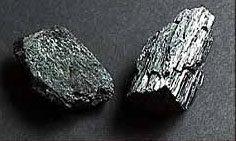amphibole

Hornblende amphibole.
An amphibole is any of a large group of rock-forming, hydrated metasilicate minerals. Amphiboles have a structure of silicate tetrahedra linked to form double endless chains (with a cleavage of about 56°), in contrast to the single chain of pyroxenes, to which they are closely related. Amphiboles are present in many igneous rocks, and also some metamorphic rocks, notably schists and gneisses. They are generally dark-colored and contain various combinations of sodium, calcium, magnesium, and aluminum.
The most important minerals in this group are tremolite, actinolite, nephrite (jade), and hornblende. Asbestos and its varieties are forms of tremolite and actinolite. Many of these occur as fine hair-like filaments, readily separable from each other; in other cases, the filaments or fibers are more or less firmly interwoven.


